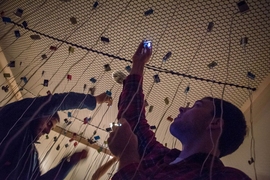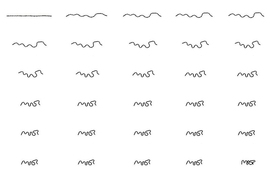We often think of the everyday materials we use to build our human world as static, but we should think again: MIT's Self-Assembly Lab programs such materials to transform themselves to handle tasks more simply and efficiently, thus improving or creating a wide variety of products.
Funded by industry collaboration, “the lab focuses on how to bring computer science to our physical world, how to program our physical world to assemble itself and transform on its own,” says Skylar Tibbits, Self-Assembly Lab head and research scientist in the MIT Department of Architecture.
“Every material responds to some sort of energy source, and every material has properties of stiffness or flexibility or expansion or contraction,” he explains. “We can have customizable smart materials that change shape, change properties, or have decision-making. We can combine them in unique ways, so that they can act as sensors, actuators, or logic.”
Tibbits gives an example of a project, in collaboration with aircraft manufacturer Airbus, involving a jet engine air inlet that traditionally causes drag during flight. The original inlet required a mechanical flap to open and close, adding weight, components, and complex controls. “We developed a piece of carbon fiber that’s completely programmable and can automatically open and close to control the airflow based on temperature, altitude, or pressure as the plane leaves the ground and flies,” he says. Such an adaptable component could minimize weight, dispense with the need for a failure-prone electromechanical actuator, and avoid the need for pilots to control it.
Designing for transformation on demand
In self-assembly, independent components come together to build a final structure completely on their own, says Tibbits, who points to many illustrations in biology and chemistry.
“We propose that you can use processes of self-assembly for large-scale applications like manufacturing or construction where it’s difficult to build things, because of environmental constraints or budget constraints or tolerance constraints,” he says.
One example is construction in space, where working is difficult, there are severe constraints on volume and weight, and there may be important advantages in components that can assemble themselves, Tibbits says. He also points to potential applications in other harsh environments and in components created on very small scales.
Moving forward with 4-D printing
Another active area of investigation for the lab is “4-D printing,” which began two years ago in a collaboration with the 3-D printing company Stratasys and the software firm Autodesk to print customizable smart materials.
“Traditional smart materials are exciting, but they’re niche materials that come in super-specific packages and sizes, are hard to assemble, and are sometimes cost-prohibitive,” Tibbits explains. “So we started printing multimaterials, which change shape or change property to go from one state to another. They go from flat sheets into 3-D objects, or they go from strands or fibers into 2-D sheets or 3-D objects. They really showed that we could customize our smart materials to respond to different energy sources and become different objects in the end.”
After demonstrating the 4-D printing concept, the lab soon found itself pursuing a number of intriguing applications with several companies.
Advancing everyday materials
The plastics employed for 4-D printing represented a small subset of materials that might be transformed, Tibbits says. That realization led the lab to develop a broad range of everyday materials for applications that go far beyond one-time assembly.
One major class of applications is robotics. “If we look at robotics today, we’re used to massive amounts of metal, sensors, electronics and actuators,” he points out. “We’re interested in streamlining that, and embedding all the capabilities of a robot into a single material that changes shape or property if a certain energy or environmental condition is around. We can have sensors, actuators, decision-making, or logic in the material itself. I think the future is not hard industrial machine robotics but robotics that is soft, resilient, adaptive, and reconfigurable.”
Programmable materials also will find important roles in making currently static products dynamic, adaptive, and reconfigurable, he says.
One example comes from a project with Briggs Automotive to adjust a rear spoiler — a wing on race cars and many street cars that can rotate upwards to increase traction on the tires by increasing drag or rotate down to increase aerodynamics. “Let’s say that if it rains, you want to increase traction on the tires,” Tibbits posits. “You can actually transform the wing panels on the car so that when they meet moisture they change and put more traction on the car. When they dry out, they become more aerodynamic and you can go faster.”
Other programmable materials could pay off in improved building environments. “We want materials that transform themselves, depending on sunlight, moisture, humidity levels, or sound,” he suggests. “For instance, acoustic panels are static, but the acoustics in the room are completely dynamic. Your acoustic panels could adapt to the noise levels in the room to help amplify the noise or help dampen it.”
Commercializing collaborations
Self-Assembly Lab researchers may have certain applications in mind as they develop new concepts such as 4-D printing. But their first corporate partners may bring quite different ideas, Tibbits says: “They’ll say, ‘Can we do it in sportswear?’ ‘Can we do it in the medical space?’”
Industry partnerships work best “when we can actually collaborate to invent the future, to think of something that no one is doing in that space and that can radically change an industry,” he emphasizes. “How can we invent completely game-changing technologies to really challenge and rethink an industry or a product? We then try to team up with our partner and transition that technology out of academia and into industry, where it can meet all of their specific requirements and be developed to become a real-world product.”
“The Self-Assembly Lab oscillates between art, design, science, and engineering,” he adds. “We may write a scientific paper and exhibit it in a gallery. Or we may start out with an art exhibition and it becomes a new technology for an industry partner. We’re excited to be on all these different spectrums. Art and design and creative endeavors are just as meaningful and fruitful for the lab as pure science and pure engineering development. We’re comfortable transitioning between any of those.”










